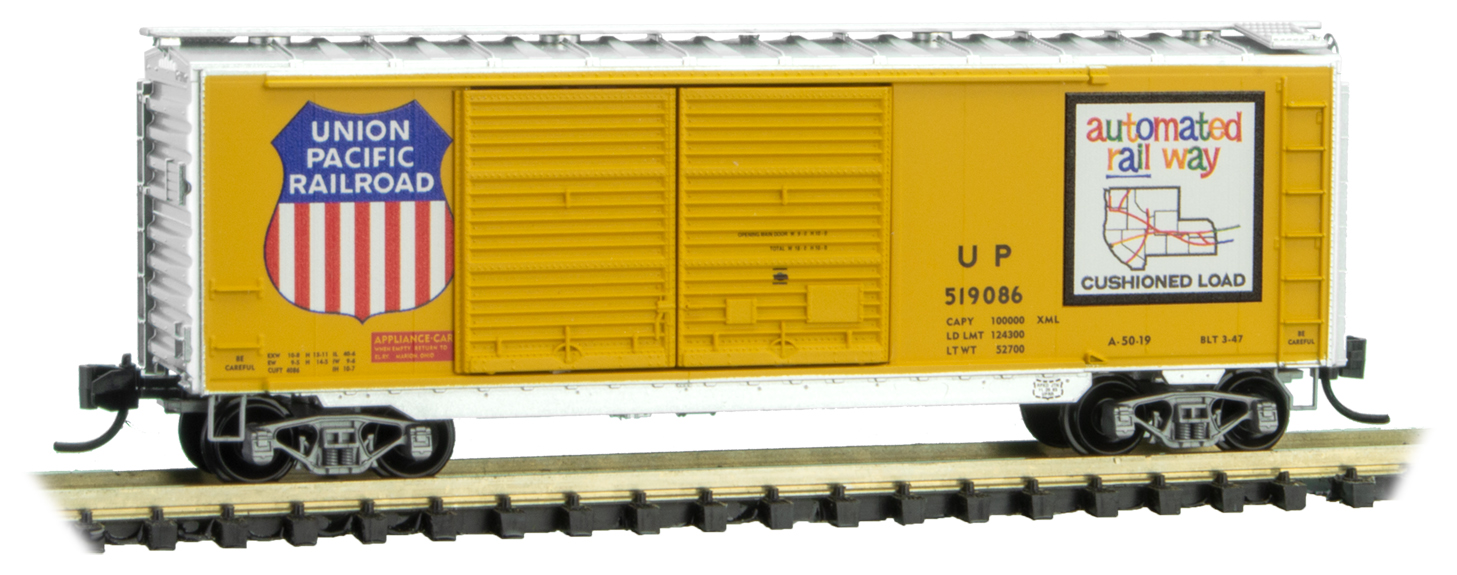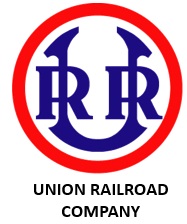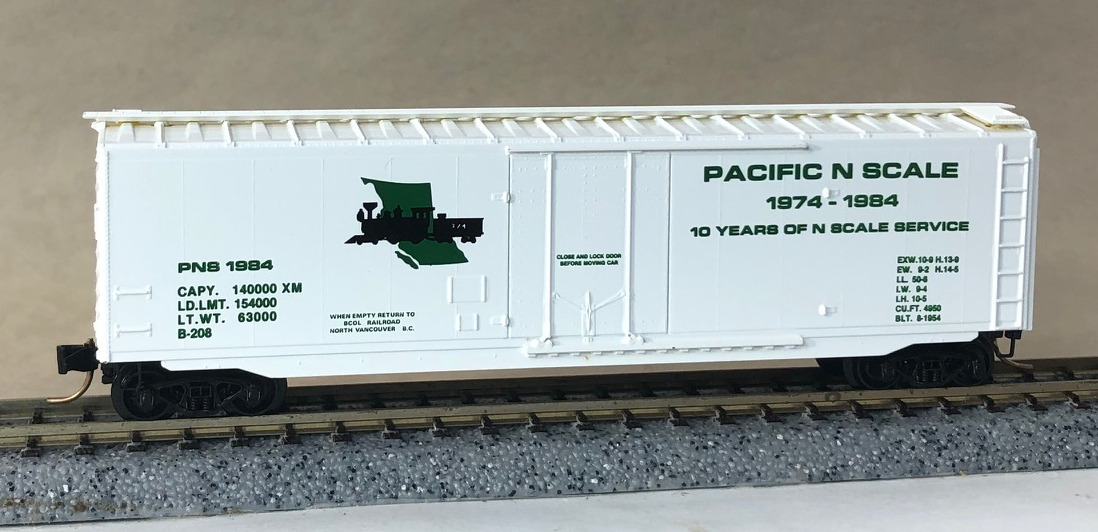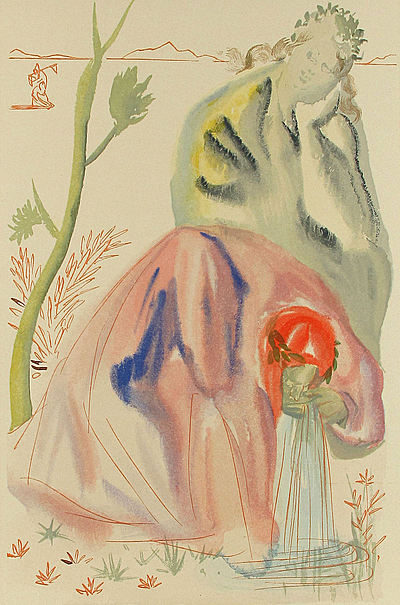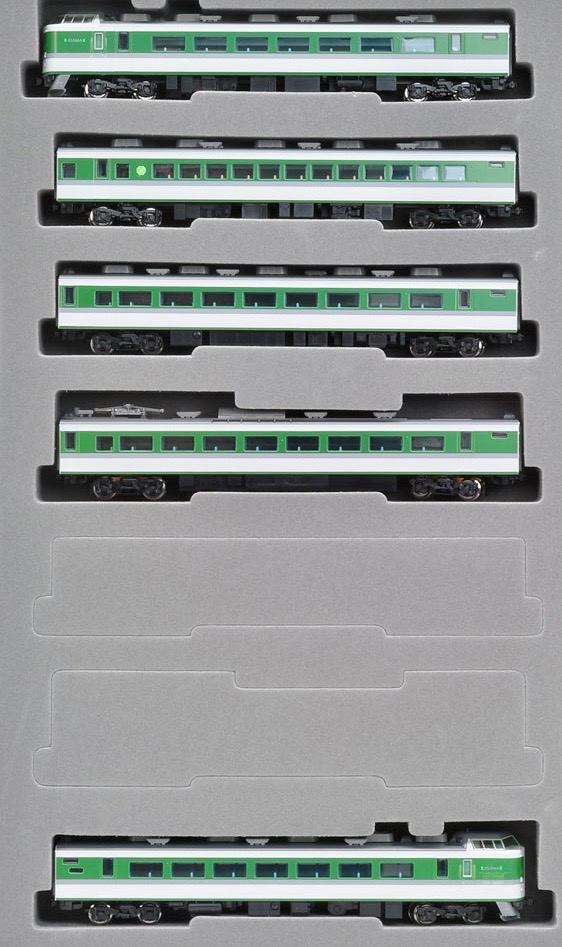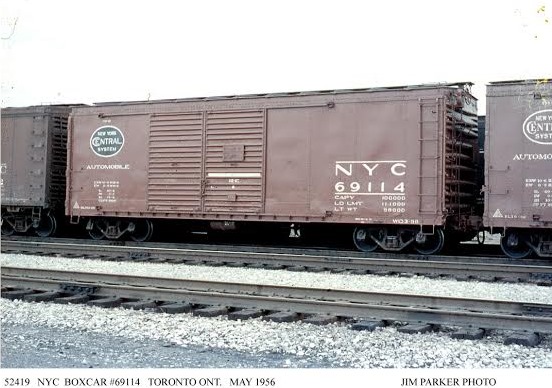Specific Item Information: These 40’ standard box cars with double doors are aluminum with yellow sides and black lettering and run on Bettendorf trucks. Built by Pullman-Standard in March 1947, this A-50-19 double-door 40’ boxcar was owned by Union Pacific and placed in Pool Service for Marion, Ohio appliance manufacturers, serviced by Erie Lackawanna.
Prototype History: Steel boxcars became a common site in the post-WWII period (also known as the transition era). Steel construction resulted in a lighter, lower-maintenance car that was less expensive to acquire and operate. The economies of scale that happened during the war along with a cessation of orders from the military resulted in a plentiful, inexpensive source of metal and aluminum for the railcar manufacturers which in turn led a complete replacement of the aging wood-sheathed fleets with new steel cars.
One common variation of the ubiquitous 40 foot steel boxcar was the double-sliding door variation. This configuration allowed for easier loading and unloading of larger objects. A common use-case was automobile transportation. In the modern era, we are used to seeing huge autoracks with up to three levels of cars stacked one on top of the other, but back during the transition era, these beasts did not exist, and car were loaded onto boxcars with this special door configuration. Although this type of car was used for other bulky objects, they were frequently labeled 'Automobile' on the sides to clearly indicate to potential customers that the railroad had the capacity to transport this large bulky objects with their fleet.
One common variation of the ubiquitous 40 foot steel boxcar was the double-sliding door variation. This configuration allowed for easier loading and unloading of larger objects. A common use-case was automobile transportation. In the modern era, we are used to seeing huge autoracks with up to three levels of cars stacked one on top of the other, but back during the transition era, these beasts did not exist, and car were loaded onto boxcars with this special door configuration. Although this type of car was used for other bulky objects, they were frequently labeled 'Automobile' on the sides to clearly indicate to potential customers that the railroad had the capacity to transport this large bulky objects with their fleet.
Road Name History: The URR opened in 1896 to serve the steel producing Monongahela River Valley region south of Pittsburgh. In 1937, it merged two other local lines. The Union is just 31 miles long but very busy. In 1951, they hauled 74 million net tons making URR the busiest railroad per mile of track in the world. The line is owned by U.S. Steel (and its successor) and at its peak served eight mills plus a number of other customers. Until recently, the tangle of Union lines crossed the Monongahela River four times. Today, Union serves USS Edgar Thomson Works which includes blast furnaces, basic oxygen process producing molten steel and a continuous caster; USS Irvin Works which includes rolling mills and finishing lines and USS Clairton Works which converts coal into coke.
The Union is the smallest railroad to have a steam locomotive wheel arrangement named for them. The uber-switcher 0-10-2 is called the Union type.
The Union diesel fleet has always been dominated by switchers, originally from EMD, Alco, and Baldwin but in later years from EMD exclusively. Road power over the years has included RS-2’s, DRS-6-6-1500’s, AS616’s, and in later years SD9’s and SD38-2’s. The number of diesels on the active roster seems to have peaked around 126 units – astounding for a 31 mile line.
Beginning in 1959 the dozen Baldwin DRS-6-6-1500’s were rebuilt with EMD prime movers and long hoods. The short hoods were also lowered. The crews called these rebuilts “buffalos.” These units retained their long hood as the front despite the nose chop and could be found leading in either direction.
Today there are 33 diesels on the active roster, all EMD SW1500’s and MP15DC’s. You may notice that all-switcher consists always have the cabs facing outward (since virtually all end cab switchers have the hood end as the front, the URR consists are nose to nose.) This method is gospel on URR and has gained favor on other lines due to improved sight lines when shoving with no loss when running with the cab end leading.
The Union connects with CSX, Norfolk Southern, CN (formerly Bessemer & Lake Erie), and Wheeling & Lake Erie at seven points along the route. Today's collection of photos takes us from the delivery of the 0-10-2's in 1936 to 1999. We will have the rest of URR collection with tomorrow's RRotD. It's worth noting that URR was known for having an aggressive security force during the transition era which explains the dearth of photos from that time.
The Union is the smallest railroad to have a steam locomotive wheel arrangement named for them. The uber-switcher 0-10-2 is called the Union type.
The Union diesel fleet has always been dominated by switchers, originally from EMD, Alco, and Baldwin but in later years from EMD exclusively. Road power over the years has included RS-2’s, DRS-6-6-1500’s, AS616’s, and in later years SD9’s and SD38-2’s. The number of diesels on the active roster seems to have peaked around 126 units – astounding for a 31 mile line.
Beginning in 1959 the dozen Baldwin DRS-6-6-1500’s were rebuilt with EMD prime movers and long hoods. The short hoods were also lowered. The crews called these rebuilts “buffalos.” These units retained their long hood as the front despite the nose chop and could be found leading in either direction.
Today there are 33 diesels on the active roster, all EMD SW1500’s and MP15DC’s. You may notice that all-switcher consists always have the cabs facing outward (since virtually all end cab switchers have the hood end as the front, the URR consists are nose to nose.) This method is gospel on URR and has gained favor on other lines due to improved sight lines when shoving with no loss when running with the cab end leading.
The Union connects with CSX, Norfolk Southern, CN (formerly Bessemer & Lake Erie), and Wheeling & Lake Erie at seven points along the route. Today's collection of photos takes us from the delivery of the 0-10-2's in 1936 to 1999. We will have the rest of URR collection with tomorrow's RRotD. It's worth noting that URR was known for having an aggressive security force during the transition era which explains the dearth of photos from that time.
Brand/Importer Information: Micro-Trains Line split off from Kadee Quality Products in 1990. Kadee Quality Products originally got involved in N-Scale by producing a scaled-down version of their successful HO Magne-Matic knuckle coupler system. This coupler was superior to the ubiquitous 'Rapido' style coupler due to two primary factors: superior realistic appearance and the ability to automatically uncouple when stopped over a magnet embedded in a section of track. The success of these couplers in N-Scale quickly translated to the production of trucks, wheels and in 1972 a release of ready-to-run box cars.
Micro-Trains Line Co. split off from Kadee in 1990 to form a completely independent company. For this reason, products from this company can appear with labels from both enterprises. Due to the nature of production idiosyncrasies and various random factors, the rolling stock from Micro-Trains can have all sorts of interesting variations in both their packaging as well as the products themselves. When acquiring an MTL product it is very important to understand these important production variations that can greatly enhance (or decrease) the value of your purchase.
Micro-Trains Line Co. split off from Kadee in 1990 to form a completely independent company. For this reason, products from this company can appear with labels from both enterprises. Due to the nature of production idiosyncrasies and various random factors, the rolling stock from Micro-Trains can have all sorts of interesting variations in both their packaging as well as the products themselves. When acquiring an MTL product it is very important to understand these important production variations that can greatly enhance (or decrease) the value of your purchase.
Item created by: CMK on 2020-02-01 05:18:30. Last edited by CNW400 on 2022-03-16 10:21:53
If you see errors or missing data in this entry, please feel free to log in and edit it. Anyone with a Gmail account can log in instantly.
If you see errors or missing data in this entry, please feel free to log in and edit it. Anyone with a Gmail account can log in instantly.


